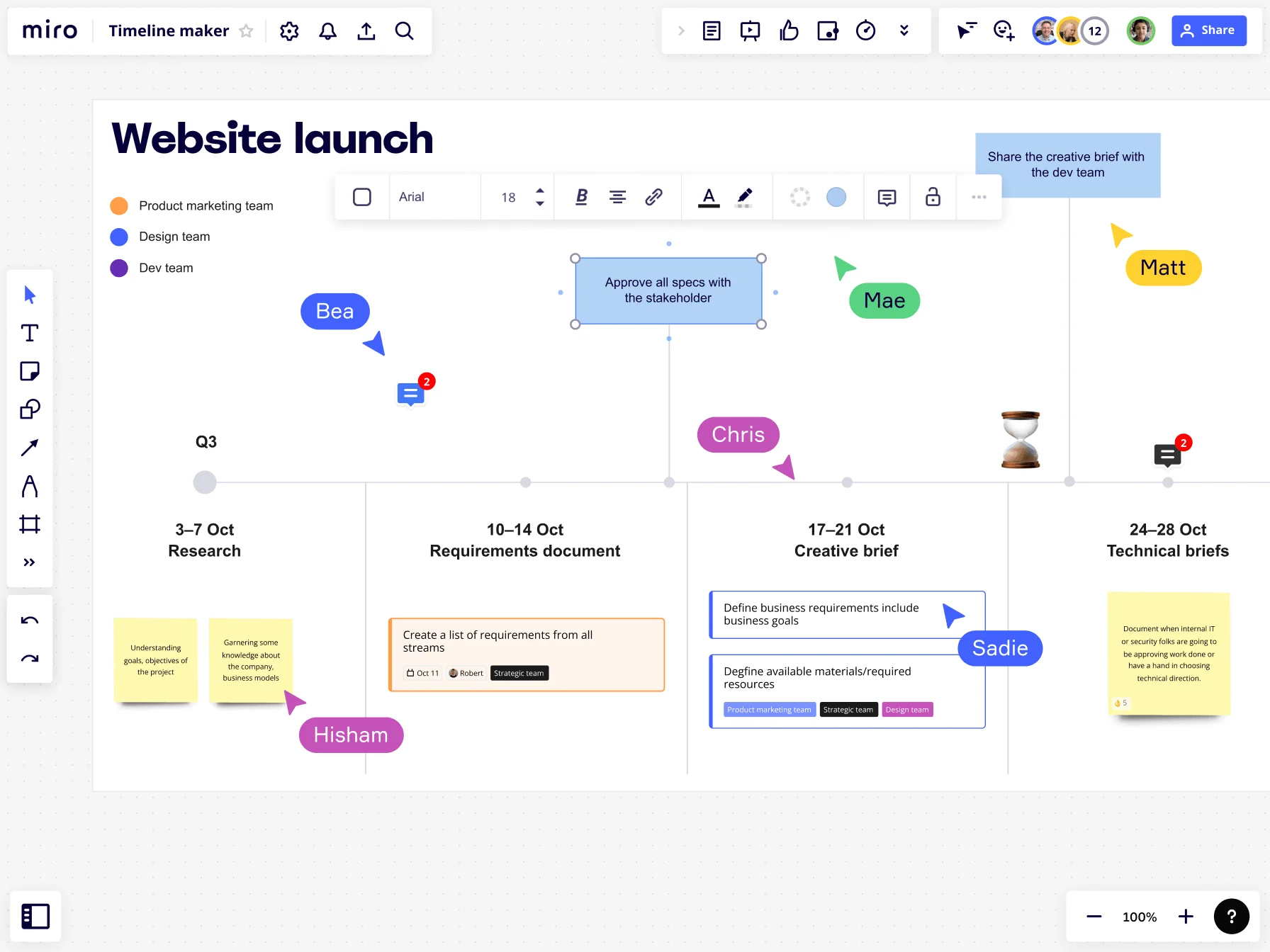Das Online Tool für strategische Planung
Miro beschleunigt deine Pläne, von der Strategie bis zur Umsetzung. Diskutiere Planungsaspekte in interessanten Sessions, gestalte visuell ansprechende Präsentationen und behalte gemeinsam mit deinem Team den Überblick über Fortschritte.

Strategie entwickeln, Umsetzung leiten
Entwickle gemeinsam Strategien und verwalte Projekte, indem du deine Denkprozesse und Daten in einem Arbeitsbereich zusammenführen. Nutze die Planning Tools von Miro, um Strategien zu entwickeln, Teams auszurichten und Pläne im gesamten Unternehmen zu kommunizieren.

Visualisiere Projekte und Abhängigkeiten
Organisiere alle Projektaufgaben und Ressourcen an einem Ort. Zeichne Abhängigkeitslinien, verwalte Arbeitslasten und nimme spontane Anpassungen vor, um auf dem richtigen Weg zu bleiben. Visualisiere auf einfache Weise Zeitpläne und den strategischen Planungsprozess von Anfang bis Ende.

Strategien präsentieren und Updates teilen
Verwandle strategische Pläne in ansprechende Präsentationen mit Live Dashboards, Wireframes und Diagrammen in schönen Rahmen. Vermittle mehr Kontext in Echtzeit, oder mache eine Aufzeichnung asynchron und stelle sicher, dass jede*r auf dem Laufenden ist.

Miro als strategisches Planning Tool

Strategische Meetings halten
Moderiere strategische Planungssitzungen, an denen jede*r teilnehmen kann, unabhängig vom Standort. Generiere Ideen, diskutiere und erstelle Pläne in Echtzeit oder arbeite asynchron weiter. Der Platz wird nie knapp und die Daten werden nie gelöscht.

Präsentiere deine Vision
Entwickle, implementiere und bewerte strategische Pläne und verwandle sie mit wenigen Klicks in ansprechende Präsentationen. Präsentiere live, oder exportiere sie als Bild oder PDF. Bette Boards als visuelle Dokumentation in Confluence, Jira und andere ein.

Sorge für agile Zusammenarbeit
Schaffe eine Kultur des Vertrauens und der Transparenz durch Sichtbarkeit und Einbeziehung. Strukturiere deine Strategie so, dass jede*r sie versteht, und optimiere die Kommunikation und die Arbeitsabläufe.

Spare Zeit
Maximiere die Ressourcen- und Zeiteffizienz durch funktionsübergreifende Abstimmung, ohne doppelte Arbeit. Nutze die Planungstools von Miro, um Prozesse zu automatisieren und schneller zur Ausführung zu kommen.
Mehr als ein online Planning Tool
Miro wurde entwickelt, um viel mehr zu tun als nur deine strategischen Prozesse zu rationalisieren. Mit intuitiven Funktionen, kollaborativen Fähigkeiten und Präzision in der Ausführung verwandelst du deine Planung in eine inspirierende und ansprechende Erfahrung und führen mit Zuversicht in jeder Organisation.
Kommuniziere Zeitrahmen, Zusammenhänge, Prioritäten und Fristen, und erstelle Arbeitsabläufe, die Projekte zum Leben erwecken.
Lerne mehr
Entwirf Projekte effizient und visualisiere alle Aufgaben in einem Zeitstrahl. Führe ansprechende Sitzungen durch und verwalte den Fortschritt kollaborativ.
Erfahre mehr
Wende die SMART Methode für dein Unternehmen an und formuliere umsetzbare Ziele. Stelle sicher, dass deine Ziele die Kriterien spezifisch, messbar, erreichbar, relevant und zeitgebunden erfüllen.
Weiterlesen
Erstelle schnell ein Diagramm von Angebot und Nachfrage und gewinne Erkenntnisse über die Preisgestaltung und die beste Art der Kundenansprache.
Lerne mehr
Das OKR Tool hilft dir bei der Implementierung und Verwaltung von Objectives and Key Results. Mithilfe von OKRs kannst du deine strategischen Ziele definieren und den Fortschritt dieser Ziele messen.
Weiterlesen
Relevante Vorlagen
Ermittle und priorisiere wichtige Strategieziele für dein Unternehmen.
Mehr erfahren
Berücksichtige alle Elemente, die du für das Erstellen einer leistungsstarken Geschäftsstrategie benötigst.
Mehr erfahren
Stellen die wichtigsten Punkte deiner Strategie vor und teile die Pläne mit deinem Team.
Mehr erfahren
Führe dein Team zu einer gemeinsame Vision und entscheide, was entwickelt werden soll.
Mehr erfahren
Identifiziere die anderen Unternehmen, mit denen dein Produkt oder deine Dienstleistung konkurriert.
Mehr erfahren
Priorisiere gemeinsam mit deinem Team die richtige Entscheidungen anhand von gewichteten Kriterien.
Mehr erfahren

FAQs Planning Tools
Wie kann ich das beste Planning Tool für mich auswählen?
Analysiere zunächst deinen Projektbedarf und -umfang, um herauszufinden, welche Frameworks für deine Anforderungen geeignet sind. Achte darauf, ein intuitives und einfaches online Planungstool zu wählen, damit alle Beteiligten auf dem Laufenden bleiben und zusammenarbeiten können. Mit Miro kannst du in Echtzeit oder asynchron arbeiten. So können sich Teams leicht vernetzen und umsetzbare Pläne und Strategien entwickeln, egal wo sie sich befinden.
Ist das Planning Tool von Miro kostenlos?
Ja! Melde dich kostenlos an, stöbere in unserer Vorlagenbibliothek und beginne sofort mit deiner Planung, direkt auf dem Board.
Entdecke mehr
Starte in Sekunden
Schließe dich den Teams an, die Miro für ihre Arbeit nutzen.




